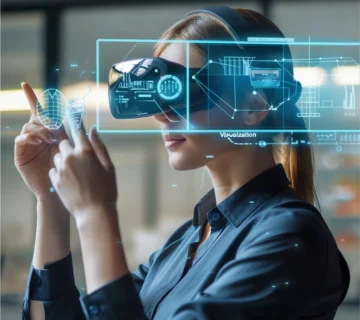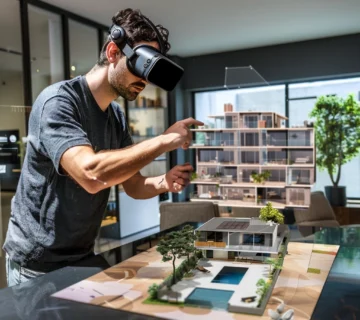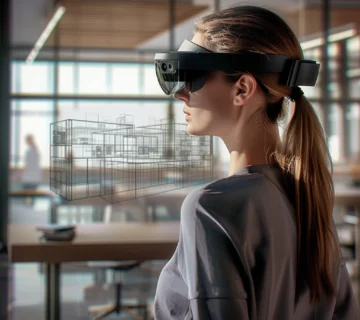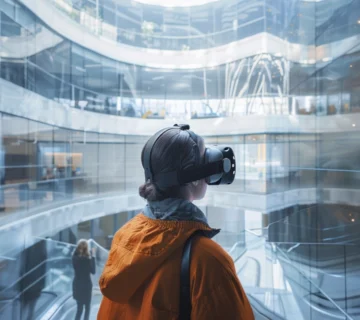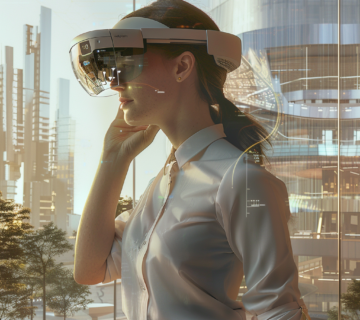Pioneering the Future of Real Estate: Top 5 Innovative Solutions of Digital Architecture
The real estate market is undergoing a remarkable transformation, largely driven by the groundbreaking developments in digital architecture. As the world becomes increasingly interconnected, architects, designers, and real estate professionals are harnessing the power of new technologies to revolutionize the architecture design, present, and experience modern architecture or futuristic architecture. In this article, we explore the top five innovative solutions of digital architecture that are reshaping the real estate market and presenting visionary concepts through cutting-edge visualization techniques.
Digital architecture meaning and trends:
Digital architecture is an evolving field that encompasses the integration of digital technologies, computer-aided design, and innovative visualization techniques in architectural practice. It represents a fundamental shift in how architects conceive, design, and present architectural spaces.
In near future “Digital spaces are becoming an accessible reality, as the metaverse is promising to enhance human interaction. Other digital tools such as robotic construction technologies, AI-generated images, and immersive virtual-reality equipment are likely to have a direct impact on the construction industry.”[archdaily]
-
Virtual Reality (VR) Property Tours
Envision the ability to stroll through your prospective home or office long before construction begins. Thanks to Virtual Reality (VR) property tours, this vision is now a reality. By donning VR headsets, prospective buyers and tenants can venture through every nook and cranny of a property, experiencing it as if they were physically present. This immersive encounter not only elevates the real estate presentation process but also enhances the decision-making process, truly revolutionizing the industry.
Moreover, this transformative technology is closely intertwined with two crucial architectural concepts—Interactive architecture and Immersive architecture. These concepts share a symbiotic relationship with the advancements in VR property tours, further expanding the horizons of architectural innovation.
-
Augmented Reality (AR) in Property Marketing
Augmented Reality (AR) has emerged as a game-changer in property marketing, offering an innovative and dynamic approach to showcasing real estate properties. With the widespread availability of AR apps on smartphones and tablets, the real estate market in digital architecture is experiencing a profound transformation. Potential buyers and tenants can now point their mobile devices at a property listing and unlock a treasure trove of information and immersive experiences.
One of the standout features of AR in property marketing is the ability to access detailed floor plans and property specifications in real-time. This means that prospective clients can navigate through the property virtually, gaining a comprehensive understanding of its layout and features, all while standing at the property’s location. This level of detail goes far beyond traditional photos and written descriptions, providing a richer and more engaging way to evaluate a property.
Moreover, AR transcends the boundaries of the physical world by introducing 3D virtual furniture placement. This feature allows users to visualize how their own furniture and decor would fit within the property. By simply pointing their device at an empty room, clients can experiment with various furniture arrangements and styles, helping them envision their future living space in a highly interactive manner.
Augmented Reality serves as the bridge between the digital and physical realms, offering potential buyers a richer, more interactive experience. It has the potential to revolutionize property marketing by creating more informed and engaged clients, ultimately enhancing their decision-making process. As AR continues to advance, it is likely to become an integral tool in the real estate industry, bringing an unprecedented level of interactivity to property marketing and presenting properties in ways we could only dream of in the past.
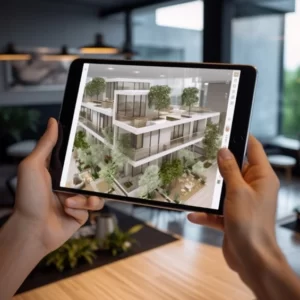
-
3D Printing for Architectural Models
Architectural models have long been a staple in real estate presentations. Now, digital architecture has taken this concept to a new level with 3D printing. Architects can create intricate, tangible models of their designs, providing potential investors and buyers with a tactile understanding of a property’s layout, scale, and design. These 3D-printed models are incredibly detailed and offer a sense of realism that traditional models cannot match.

-
Interactive Building Information Models (BIM)
Building Information Models (BIM) have been a cornerstone of building architecture and construction for some time. Now, digital architecture is making them interactive. Interactive BIM models allow users to explore a property’s interior architecture and exterior architecture design, systems, and specifications in detail. Changes and modifications can be visualized in real time, offering a dynamic and collaborative platform for architects, builders, and clients.
-
Smart Home Simulations
The concept of the smart home is gaining traction, and digital architecture is facilitating its integration into the real estate market. Using digital simulations, potential buyers can experience the full range of smart home features, from automated lighting and security systems to climate control and entertainment. These simulations provide a glimpse into the future of real estate, where technology and convenience are seamlessly integrated.
Unveiling the Digital architecture Revolution: The Future of Real Estate
The real estate landscape is on the cusp of a digital architecture revolution that is reshaping the very essence of architectural design and presentation. Digital architecture is at the forefront of this transformation, pushing the boundaries of how we perceive, construct, and engage with architectural spaces. As we journey deeper into the 21st century, it becomes increasingly evident that our understanding of real estate is undergoing a profound metamorphosis.
The foundation of this revolution is rooted in cutting-edge technologies that allow us to explore architectural spaces in ways previously unimaginable. Immersive property tours, driven by virtual reality (VR) and augmented reality (AR), are bringing properties to life before they are even built. These immersive experiences are not merely a glimpse of the future; they are the future, providing potential buyers and tenants the ability to physically step into a property from the convenience of their devices.
Moreover, digital architecture empowers us to create intelligent homes that are in tune with our needs. The concept of a “smart home” is evolving from a futuristic idea to a reality. Homes equipped with smart technologies that adapt to our preferences for lighting, temperature, and security are becoming the new standard. This fusion of architecture and technology is creating living spaces that cater to our comfort and efficiency, enhancing our quality of life.
Sustainability is also a cornerstone of this digital architecture revolution. The real estate of the future is inherently eco-conscious, with sustainable practices and materials seamlessly integrated into design and construction. Buildings are now harmonizing with the environment, utilizing green technologies and renewable energy sources to reduce their ecological footprint. Digital architecture facilitates the visualization and implementation of sustainable designs that coexist with the natural world.
In this dynamic era of real estate, the line between the physical and digital worlds is blurring. The digital realm is becoming an integral part of our real estate experience, offering new dimensions for presenting and interacting with properties. As innovation continues to push the boundaries of what is possible, we stand on the precipice of extraordinary transformations in the real estate industry, with digital architecture leading the way into an era of limitless potential.
In this exciting era of real estate, where sustainable architecture is of paramount importance, digital architecture plays a pivotal role in the presentation of exterior architecture projects. The approach to sustainable architecture is becoming increasingly synonymous with the way exterior architecture projects are portrayed. By utilizing cutting-edge visualization techniques and immersive digital tools, architects and designers are able to vividly communicate their commitment to sustainability and environmentally conscious design, offering a vision of a greener and more harmonious architectural future.
Discover HUUR STUDIOS: Your Gateway to Innovation in Digital Architecture
When it comes to harnessing the power of digital architecture in the real estate sector, HUUR STUDIOS is at the forefront of innovation. Our services encompass all aspects of digital architecture, from immersive VR property tours to interactive BIM models and beyond. With our expertise, your real estate projects can benefit from these cutting-edge technologies, enhancing presentation, decision-making, and the overall real estate experience. As we move into the future, HUUR STUDIOS is your trusted partner in pioneering the next era of real estate through digital architectural innovation.
Figure 3: Illuminating Innovation: Design and Visualization of the Lighting Virtual Gallery by HUURSTUDIOS
Conclusion:
In conclusion, digital architecture is ushering in a new era for the real estate market. These innovative solutions, including VR property tours, AR in property marketing, 3D-printed architectural models, interactive BIM, and smart home simulations, are not only changing the way we present real estate but also redefining the way we experience and interact with architectural spaces. As technology continues to advance, we can expect even more creative applications of digital architecture in the real estate sector, shaping a future where visualization and interactivity are at the forefront of property presentations.




